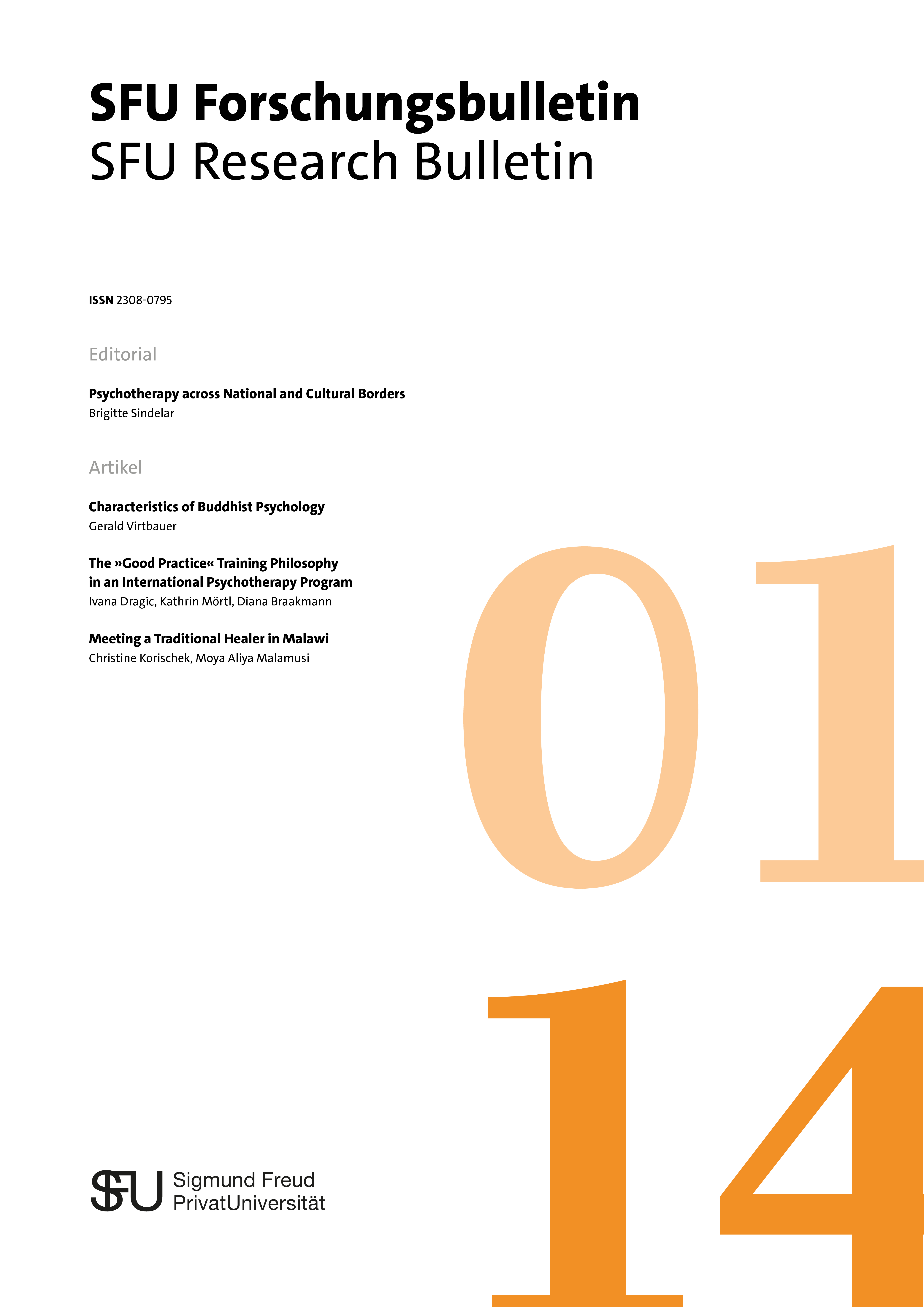Characteristics of Buddhist Psychology
DOI:
https://doi.org/10.15135/2014.2.1.1-9Abstract
Fünf Kennzeichen buddhistischer Psychologie werden erläutert — buddhistische Psychologie als psy-chologisches, phänomenologisches, pragmatisches, empirisches und therapeutisches System. Diese Klärung verdeutlicht, warum die indigen buddhistische Psychologie eine entscheidende Rolle in der gegenwärtigen Psychotherapiewissenschaft einnimmt.
Literaturhinweise
(Abbreviation: PTS – Pali Text Society ed. [references to volume and page(s)])
AN — Aṅguttara Nikāya. PTS.
Anālayo. (2003). Satipaṭṭhāna: the direct path to realization. Cambridge: Windhorse Publications.
Bechert, H. (2004). Buddha, Life of the. In R. E. Buswell, Jr. (Ed.), Encyclopedia of Buddhism (Vol. 1, pp. 82–88). New York: Macmillan Reference USA.
Berry, J. W., Poortinga, Y. H., Breugelmans, S. M., Chasiotis, A., & Sam, D. L. (2011). Cross-cultural psychology: research and applications (3rd ed.). Cambridge: Cambridge University Press.
Bhawuk, D. P. S. (2010). Methodology for building psychological models from scriptures: contributions of Indian psychology to indigenous and universal psychologies. Psychology and Developing Societies, 22(1), 49–93. doi: 10.1177/097133360902200103
Bodhi, B. (Ed.). (2007). A comprehensive manual of Abhidhamma: the philosophical psychology of Buddhism. The Abhidhammattha Saṅgaha of Ācariya Anuruddha (3rd ed.). Kandy, Sri Lanka: Buddhist Publication Society.
DN — Dīgha Nikāya. PTS.
Farb, N. A. S., Anderson, A. K., Mayberg, H., Bean, J., McKeon, D., & Segal, Z. V. (2010). Minding one’s emotions: mind-fulness training alters the neural expression of sadness. Emotion, 10(1), 25–33. doi: 10.1037/A0017151
Farb, N. A. S., Segal, Z. V., Mayberg, H., Bean, J., McKeon, D., Fatima, Z., & Anderson, A. K. (2007). Attending to the present: mindfulness meditation reveals distinct neural modes of self-reference. Social Cognitive and Affective Neuroscience, 2(4), 313–322. doi: 10.1093/Scan/Nsm030
Gombrich, R. F. (2009). What the Buddha thought. Sheffield: Equinox Publishing.
Harvey, P. (2000). An introduction to Buddhist ethics: foundations, values, and issues. Cambridge: Cambridge University Press.
Hayes, S. C., Follette, V. M., & Linehan, M. M. (Eds.). (2004). Mindfulness and acceptance: expanding the cognitivebehavioral tradition. New York: Guilford Press.
Heidenreich, T., & Michalak, J. (Eds.). (2004). Achtsamkeit und Akzeptanz in der Psychotherapie: Ein Handbuch. Tübingen: dgvt-Verlag.
Kuan, T.-f. (2008). Mindfulness in early Buddhism: new approaches through psychology and textual analysis of Pali, Chinese and Sanskrit sources. London: Routledge.
Mikulas, W. L. (2011). Mindfulness: significant common confusions. Mindfulness, 2(1), 1–7. doi: 10.1007/s12671-010-0036-z
MN — Majjhima Nikāya. PTS.
Ñāṅananda, B. (1976). Concept and reality in early Buddhist thought: an essay on “papañca” and “papañca-saññā-saṅkhā” (2nd ed.). Kandy, Sri Lanka: Buddhist Publication Society.
Rao, K. R. (2008). Prologue: introducing Indian psychology. In K. R. Rao, A. C. Paranjpe & A. K. Dalal (Eds.), Handbook of Indian psychology (pp. 1–19). New Delhi: Cambridge University Press India.
Rapgay, L., & Bystrisky, A. (2009). Classical mindfulness: an introduction to its theory and practice for clinical application. Longevity, Regeneration, and Optimal Health: Integrating Eastern and Western Perspectives; Annals of the New York Academy of Sciences, 1172, 148–162. doi: 10.1111/J.1749-6632.2009.04405.X
Rapgay, L., Bystritsky, A., Dafter, R. E., & Spearman, M. (2011). New strategies for combining mindfulness with integrative cognitive behavioral therapy for the treatment of generalized anxiety disorder. Journal of rational-emotive and cognitive-behavior therapy, 29(2), 92–119.
Safran, J. D. (Ed.). (2003). Psychoanalysis and Buddhism: an unfolding dialogue. Boston: Wisdom Publications.
Segal, Z. V., Williams, J. M. G., & Teasdale, J. D. (2002). Mindfulness-based cognitive therapy for depression: a new approach to preventing relapse. New York: Guilford Press.
SN — Saṃyutta Nikāya. PTS.
Soma, T. (Trans.). (1959/2008). Kālāma Sutta: the Buddha’s charter of free inquiry. The Wheel Publication No. 8, (pp. 7). Retrieved July 3, 2013, from http://www.bps.lk/olib/wh/wh008.pdf
Virtbauer, G. (2008). Psychologie im Erkenntnishorizont des Mahāyāna-Buddhismus: Interdependenz und Intersubjektivität im Beziehungserleben. Frankfurt am Main: Peter Lang.
Virtbauer, G. (2009). Das Zen-buddhistische Selbst-Konzept. Eine Erläuterung anhand Dōgen Zenji’s Shōbōgenzō. e-Journal Philosophie der Psychologie, 12. Retrieved from http://www.jp.philo.at/texte/VirtbauerG1.pdf
Virtbauer, G. D. (2010). Dimensions of intersubjectivity in Mahāyāna-Buddhism and relational psychoanalysis. Contemporary Buddhism, 11(1), 85–102. doi: 10.1080/14639941003791584
Virtbauer, G. (2011). Bewusstsein und Beziehung im Mahāyāna-Buddhismus. Ein integrativ religionspsychologischer Ansatz. e-Journal Philosophie der Psychologie, 15. Retrieved from http://www.jp.philo.at/texte/VirtbauerG2.pdf
Virtbauer, G. (2012). The Western reception of Buddhism as a psychological and ethical system: developments, dialogues, and perspectives. Mental Health, Religion & Culture, 15(3), 251–263. doi: 10.1080/13674676.2011.569928
Virtbauer, G. (2013). Bewusstsein und Achtsamkeit in der buddhistischen Psychologie. In U. Anderssen-Reuster, S. Meck & P. Meibert (Eds.), Psychotherapie und buddhistisches Geistestraining: Methoden einer achtsamen Bewusstseinskultur (pp. 263–276). Stuttgart: Schattauer.
Vism — The path of purification (Visuddhimagga) by Bhadantācariya Buddhaghosa. (1957/1999). (B. Ñāṇamoli, Trans.). Onalaska, WA: BPS Pariyatti Editions. [references to chapter and paragraph(s)]
Warder, A. K. (1991). Introduction to Pali (3rd ed.). Oxford: Pali Text Society. (1st ed. 1963)
Williams, J. M. G., & Kabat-Zinn, J. (2011). Mindfulness: diverse perspectives on its meaning, origins, and multiple applications at the intersection of science and dharma. Contemporary Buddhism, 12(1), 1–18. doi: 10.1080/14639947.2011.564811
